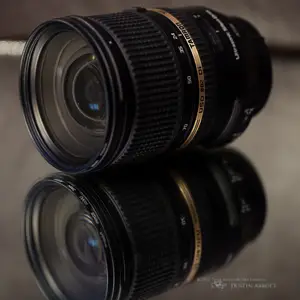Tamron SP 24-70mm f/2.8 Di VC USD Review
Dustin Abbott
November 29th, 2012
 I am scarcely the first person to write a review of Tamron’s new fast standard zoom, the Tamron SP 24-70mm DI VC USD (yes, Tamron loves long names for their lens!). There is a reason why this lens has gotten so much attention, however, and that is because it has not only dared to play in the big boys’ playground, it has even brought some new moves of its own. I am speaking of course of its image stabilization, or Vibration Compensation (VC) in Tamron speak. And that inclusion is what makes this lens a game changer. Tamron has managed to build a lens that is similar in size and sporting similar image quality to the Canon and Nikon equivalents while also fitting an excellent VC system into the package. Tamron has undercut Canon and Nikon’s price, but that is no surprise. In fact, it is more surprising the price that this lens is commanding. It’s MRSP is currently the highest in Tamron’s lineup of consumer lens and is more than 2 ½ times that price of Tamron’s previous standard zoom, the SP 28-75mm f/2.8. Which leads us to the first point of consideration:
I am scarcely the first person to write a review of Tamron’s new fast standard zoom, the Tamron SP 24-70mm DI VC USD (yes, Tamron loves long names for their lens!). There is a reason why this lens has gotten so much attention, however, and that is because it has not only dared to play in the big boys’ playground, it has even brought some new moves of its own. I am speaking of course of its image stabilization, or Vibration Compensation (VC) in Tamron speak. And that inclusion is what makes this lens a game changer. Tamron has managed to build a lens that is similar in size and sporting similar image quality to the Canon and Nikon equivalents while also fitting an excellent VC system into the package. Tamron has undercut Canon and Nikon’s price, but that is no surprise. In fact, it is more surprising the price that this lens is commanding. It’s MRSP is currently the highest in Tamron’s lineup of consumer lens and is more than 2 ½ times that price of Tamron’s previous standard zoom, the SP 28-75mm f/2.8. Which leads us to the first point of consideration:
Build Quality
I will be honest: I am somewhat of a Tamron fan. My bag is full of Canon lens, including the 17-40mm f/4L, 24-105mm f/4L IS, 40mm f/2.8 STM, 85mm f/1.8, 100mm f/2.8L Macro IS, 135mm f/2L, and 70-200mm f/4L IS. 7 Canon lens, 5 of which are of Canon’s premium “L” lineup. So why do I say I am a Tamron fan? I have previously owned the Tamron 17-50mm f/2.8, 28-75mm f/2.8, 18-270mm f/3.5-6.3, 70-200mm f/2.8, and currently own the 70-300mm f/4-5.6 VC USD lens. I have experience with Tamron lens, and have come to the following conclusion: Tamron lenses frequently offer 90+ percentage of the equivalent Canon image quality at as little as 1/3rd of the price, but the trade-off has always been ergonomics. I have tried a few Sigma lens (and heavily researched others), and find the opposite to be true. Sigmas often feature great ergonomics (nice build quality, fast, quiet focus) but inferior image quality. Image quality matters most to me, so I frequently went with Tamrons when I couldn’t afford the Canon equivalents.
But there was a downside. The Tamrons were frequently, to be frank, cruder implements than the competition. Buzzy AF motors that were not quite as fast, cheaper feeling components, and somewhat looser tolerances in the build quality. They were almost always smaller and lighter than the competition, but felt cheaper. The slow AF speed of the Tamron 70-200mm made it unusable for event work despite its great image quality. That began to change when Tamron introduced the SP 70-300mm f/4-5.6 VC USD telephoto lens (which I own). It also featured very good image quality, but there were some significant improvements. It had perhaps the best (to that point) implementation of Tamron’s new VC (Vibration Compensation) system, which has been widely lauded as simply excellent, despite this being a new field for Tamron. It also made a big jump in the focusing motor, what Tamron calls Ultrasonic Drive (USD). It directly challenged Canon’s USM (Ultrasonic Motor) system with a fast, quiet focusing motor of its own. The build quality was also vastly improved, with a heavy, solid feeling lens that has (thus far) held up for me very well. It came with Tamron’s excellent warranty (6 years vs. 1 for Canon) and still managed to undercut Canon’s equivalent lens (70-300mm f/4-5.6 IS USM) in price while providing arguably better optics.
This new lens builds upon that foundation but is even more ambitious. It directly goes into Canon and Nikon professional territory and attempts to compete more on merit than value. It is the first Tamron lens to incorporate weather sealing and go after the more professional photographer’s kit. Its size is very comparable to the Canon and Nikon equivalents, although it does manage to incorporate VC into that package. It is somewhat lighter and shorter, but also a little thicker through the barrel. One major downside for me was that it went to an 82mm filter thread, making my nice selection of 77mm filters entirely useless for this lens. This unfortunately appears to be somewhat of a trend, as Canon has recently released several lens that use this filter size (including the MK2 version of their own 24-70mm f/2.8L). I’m afraid that photographers may just have to accept this trend. Speaking of that lens, Tamron’s asking price of roughly $1300 seemed somewhat ambitious until Canon released the MSRP on their new lens and it came in at more than $1000 more! To be fair, the lens has been acclaimed as having some of the best optics in a zoom lens to date, but its price is still staggering.
The new Tamron is very nicely constructed. It feels “substantial” – solid and professional, with a metal mount and nice tolerances on the primarily polycarbonate body. The zoom and focus rings have a nice rubberized feel and are nicely damped. It is not dissimilar in build (or size) to my Canon EF 24-105mm f/4L IS, which is certainly not a bad thing. It has a distance window, switches for AF/MF and VC (although full time manual override is also available), and a lock to prevent zoom creep. My experience has been that zoom creep is next to nil; it did very slightly creep when in my chest holster (with the lens point straight down) and doing heavy hiking. My guess is that many users will never have to use the zoom lock at all, but it nevertheless a nice little touch for the small percentage who will use it. It should be noted that the Tamron is both shorter and lighter than the Canon 24-70mm f/2.8 MK1 and roughly similar in size to the MK2. One positive for me is that due to the closer fit of the lens hood while reversed, the overall width of the Tamron for storage is slightly smaller than the 24-105L despite its larger front element. The 24-105L is a tight squeeze in my Lowepro 2S bag, while the Tamron slides in nicely. Here are some comparison photos for the size of the two zooms.
[sliderly id=880 type=gallery width=auto height=auto grid =2 colorbox=true]
In conclusion, the build quality is very strong with this lens. It bears no resemblance to Tamron’s of old. In fact, Tamron has always used the gold ring and the SP badge for its “premium” lens in the past. This lens and the upcoming 70-200mm f/2.8 VC USD seem like they should have some new badge to set them apart, for they are really the first truly premium lens that Tamron has produced. This lens is in no way out of place amongst my “L” lens other than lacking that red ring.
Autofocus
As I have previously said, this has been a point of vulnerability in the past. Many of the Tamron lens that I have used have featured very buzzy, cheap sounding focusing motors. My 70-300mm was a huge step up in that regard, and, while not quite as fast as, say, my 135L, it was fast enough that you never think about it. The 24-70mm is similar, although I would guess just marginally slower. It focuses quickly, quietly, and accurately, but there is a difference between it and the best USM motors. If I could put it this way: when focusing, you get a sense that some heavy elements are being moved into place (which they are), but this is not quite as well masked as some of my “L” quality lens. To be fair, this isn’t to say that all high end Canon glass with USM motors are perfect; lenses like the 85mm f/1.2L and 50mm f/1.2L are not exactly renowned for their fast focus motors, for example. But Tamron is still a step behind Canon in this regard in this class of lens.
Most importantly, however, I found that the focusing was very accurate in this lens (a sentiment others have shared as well). When focus locks, it is well focused. It seems to operate well in dim lighting, important, considering that I intend to use the lens a lot for event work. The accuracy is what makes me unafraid to take this lens “into battle”. My keeper rate has been very high.
Image Quality
Here is where the rubber meets the road for me. My goal in buying this lens was to move away from two prime lens (an EF 35mm f/2 and 50mm f/1.4) that had previously covered this focal length. Both of these lenses when used properly have very good image quality. I was buying an f/2.8 lens for a reason; a good percentage of my shots will be shot at maximum aperture. I need the image quality to supplement the three very good primes I will be shooting above this focal range (85,100L,135L). I am going to break down my conclusions into usable information. If you want test charts, look elsewhere.
First, it is clear that this is optimized for event/portraiture work. At medium distance it is incredibly sharp, particularly in the center of the frame. Wide open images are sharp and contrasty, with an excellent quality. I have been very pleased with portrait captures and fine art shots using a narrow depth of field and isolating an element. Furthermore, the transition to out of focus (ooF) area is very smooth. I am very pleased with the quality of the bokeh (more on that in a moment). For this kind of work the lens is very, very pleasing:
Image quality is also excellent at minimum focus distance. Not all lens resolve well at their minimum focus distance, but this lens does an excellent job. It closes quite closely (less than a foot at 70mm), and zooming into the images reveal fine detail very nicely resolved. When I saw that, I purposed to test the lens with an extension tube and was very pleased with the final product. Great resolution of detail, and, to be honest, it focuses as closely with a 31mm extension tube as I ever use my macro lens. It also maintains that very smooth transition to ooF. It is here that the excellent VC system becomes handy, because even if shooting at faster speeds than what VC would require, Tamron’s VC really helps to hold the image in the viewfinder steady, which allows you to be precise with focus (which is incredibly crucial at macro distance). I was able to consistently produce excellent images handheld at near macro distances.
[sliderly id=904 type=gallery width=500 height=500 grid=3 colorbox=true]
I am less impressed with this lens as a landscape lens. The extreme corner performance becomes more important, and frankly that isn’t this lens strength. I find that it is noticeably sharper in the center at equivalent apertures than my 24-105L, but the extreme corners (particularly on the bottom) are definitely better on the 24-105L or my 17-40L. There is a secondary issue at work here – I find that optimum image quality comes early in this lens and that diffraction also sets in early. To be more plain, an image at f/8 looks somewhat sharper upon close inspection than an image at f/11. I have ordered a second copy for comparison on this regard. This is a two edged sword, as it means that maximum image quality comes early in this lens (no more than f/5.6) throughout most of the frame. That is great for the majority of how and why I will be using the lens. For those looking to use it as a replacement landscape lens, you would probably be better served with another choice. I feel that both my 24-105L and 17-40L would better serve for landscape purposes. The reviews that I have read suggest that the MKII of Canon’s 24-70L is exceptional in this regard. Update: I am happy to report that my second copy of the lens seems more consistent across the frame. It is crisper at f/11 than my previous copy while retaining the excellent clarity in closer focal lengths. Extreme corners are still not the greatest strength of the lens, though. Three notes from further tests: 1) The 24-105mm is wider at 24mm than the Tamron 2) The Tamron is slightly warmer in color rendering than the Canon and 3) The Tamron controls chromatic aberrations MUCH better than the Canon. This last point aside, I stand by my previous assessment. I feel that I have a very sharp copy of the 24-105L (my second), and the Tamron compares favorably except in the extreme corners. It is noticeably sharper in the center. It can produce stunning landscape images (see below), but I don’t get the impression that this was the primary purpose of the lens.
[sliderly id=910 type=gallery width=500 height=500 grid=3 colorbox=2]
My conclusion is that this lens is optimized for close to medium range. It is still capable of producing very nice landscape type images, but I do not feel that infinity focus distances are the lens’ strength.
Bokeh
This has been a source of some debate with this new lens. Some would argue that the bokeh/out of focus quality in a standard zoom lens isn’t great, anyway. The Tamron specifically has come under some fire for what has been frequently labeled “onion bokeh” (or having some rings within a bright specular highlight that resembled the layers of an onion when cut in half). I have observed this phenomena in only one instance when I had one very bright light source in the OOF area of the image (a car headlight, in this case). I saw it mostly because I was looking for it. That being said, I have actually been quite pleased with the bokeh rendering of this lens for another reason: the smoothness of the transition from focus to defocus. This is a big deal to me, and I was pleasantly surprised when I closely examined my first images from the lens. The lens is very sharp in the focused area, but then smoothly transitions to the defocused area of the lens.
I was also impressed when doing close focus work with the lens. In macro/close focus work this becomes very, very important. The Tamron did an excellent job, as illustrated in this macro and close focus crops. I would certainly agree that the MKII of the Canon is better, but overall this Tamron has nothing to be ashamed of.
All of this being said, if you intend to do a lot of small aperture shooting with bright lights in the background (night/street photography, for example), this is something you might want to consider. Many other fast lens also exhibit the “onion bokeh” (it was even more pronounced in my Tamron 17-50mm f/2.8), but it simply wasn’t a big deal to me. It might be to you… But judging from my own images, I would say that the bokeh rendering on the lens is very pleasing.
[sliderly id=886 type=gallery width=500 height=500 grid=3 colorbox=true]
Vignetting
This has been another criticism of the lens that I have read. In full disclosure, I do have to confess that this is rarely a big deal to me personally. I frequently add a vignette in post processing anyway because I personally like the look as I feel it frequently helps to focus the eye on the primary subject. This is particularly true when I shoot portraiture, which is certainly one of the very viable uses of this lens. I own five lens with an aperture of 2.8 or wider, so I am very accustomed to some light fall-off. In all fairness, this is an area where third party lenses take a bit of hit as many cameras have a “Peripheral Illumination” setting that is often of by default. This simply means that in a Canon camera the camera will automatically correct for this if it has the lens profile loaded. Guess how many third party profiles are loaded? If you guesses “zero” you would be right. This means that frequently a Canon equivalent lens may suffer from as much or more vignetting but it shows up less often. It becomes a moot point for me, as Lightroom already has a profile for this new Tamron that corrects this on import for me. The Tamron is about middle of the pack for vignetting amongst its competitors, and it has been my experience thus far that I have not noticed it. In fact, I find that the vignetting on my 24-105L is more field noticeable than the Tamron despite it maximum aperture being a stop slower. Tamron is on the left (wide open at f/2.8, 24mm). Canon on the right (wide open at f/4, 24mm). I seriously doubt that most shooters will find vignetting to a serious issue on this lens.
[sliderly id=925 type=gallery width=500 height=500 grid=2]
One Minor Niggle
24-70mm is somewhat of an exaggeration. Apparently this isn’t uncommon. The angle of view is similar to other 24-70s, which suggests that this focal range is more of a suggestion in this class. It is not as wide at 24mm as my 24-105L and less so than my 17-40mm set at 24mm. At 70mm its reach is not equal to the beginning point on either my 70-200 f/4L or my 70-300mm Tamron. It is probably something like 25-65mm at best. As I said, this is not uncommon for this class, but it is annoying nonetheless. REVISION: I have tested my second copy extensively and have found that while my conclusions about the long end remain valid, this second copy is actually slightly wider than 24mm on either my 24-105L or 17-40L. It would seem that the focal length is actually about 23mm (or even marginally wider) at the wide end. This is a big plus!!
Conclusion
I have done my best to be open minded about this lens as I have given feedback on it. I personally did a lot of research before taking the plunge on the lens myself. On that note, I purchased this lens from Simon’s Camera out of Montreal. They had the best price in Canada and provided excellent service. I even exchanged my first copy of the lens for a second because I felt the VC could be better (the second unit does seem to function better). There was no hesitation when I asked about exchanging copies, and they even paid to ship the second unit to me. I enjoyed doing business with them, and Kevin in sales was extremely friendly, professional, and helpful.
But I was researching more than price. At this stage I do earn money from photography and need my gear to function during critical moments. I will be using this lens during various events, including weddings, when you only get one shot at certain moments. Portraits are not an issue. I often use old manual focus lens as a part of my workflow in those situations without fear. But events are another matter. Do I feel confident taking this lens “into battle”? I feel comfortable in saying “yes” from my testing to date. The AF is not the fastest in my kit, but the combination of “enough” AF speed, and, more importantly, AF accuracy makes me feel comfortable that I will be able to get the shots that I need. Furthermore, the VC in this lens means that I should be able to get clear shots of static scenes without fear of vibration. I don’t shoot a lot of DSLR video, but often when I do it is handheld in the field. The VC system works exceptionally well in that setting. Finally, I have field tested the lens in every scenario from near macro to landscape photography and feel confident in this lens’ ability to produce great images, even at its widest aperture. Sometimes pictures look great in a smaller size, but when you zoom into them the image quality falls apart. Not so with this lens. I consistently find the image and detail looks better as I zoom in. The lens has a very high resolving power, which is just huge to me! So, in my conclusion, I feel that this lens represents the right balance of quality and price for me of the options available. I have now also used the lens in a wedding situation, which I blogged about here.
Is it the lens for you? Only you can answer that, but I hope that this review from a real photographer has been helpful. Take a look at the gallery of images for yourself and determine if it is a lens that you could use. All images taken with a Canon EOS 5D MKII and processed through my standard techniques.
Great News! I can now offer a 5% discount on all purchases at Amplis Foto, Canada’s Leading Photographic Supplier. Please enter discount code: AMPLIS52014 in your cart. It is good for everything in your cart, andis stackable with other coupons, too! It will take 5% off your entire order! If you want to go directly to this lens, click here: Proceeds go towards keeping this site going and providing you with new reviews!
FOR MY AMERICAN READERS: I have now have a relationship in place with B&H for my American readers. B&H is one of the leading photography retailers on the planet, and they offer not only great prices but a cash back program. Click here in the mount of choice to get a great price on this lens. By using this link you help to support this site and keep it running. I’ll do my best to keep great new reviews coming your way!
[sliderly id=930 type=featuredimg width=auto height=auto colorbox=true]
DISCLAIMER: This article and description contains affiliate links, which means that if you click on one of the product links, I’ll receive a small commission. As an Amazon Associate I earn from qualifying purchases.
12 thoughts on “Tamron SP 24-70mm f/2.8 Di VC USD Review”
Leave a Reply
You must be logged in to post a comment.











 Canon EOS R8 Review
Canon EOS R8 Review  Fujinon XF 18-55mm F2.8-4 LM OIS 40MP 2024 Review
Fujinon XF 18-55mm F2.8-4 LM OIS 40MP 2024 Review  Viltrox AF 56mm F1.7 X-Mount Review
Viltrox AF 56mm F1.7 X-Mount Review  Viltrox AF 56mm F1.7 X Mount Gallery
Viltrox AF 56mm F1.7 X Mount Gallery 






I am very pleased with my Tamron 24-70mm f2.8 VC usd for Nikon lens. I read all sorts of reviews on the lens many of which compared it very favorably with the Nikon and Canon counterparts. I have used the Nikon 24-70 f2.8 as a rental on occasion however if I wished to purchase the VR version I would have had to spend $1300 plus tax more for Nikon’s VR version. After running the Tamron through its paces after my purchase and now having had the lens for about 3months of shooting I can honestly say you would really have to have deep pockets to purchase the Nikon or Canon 24-70mm. This lens performs so close and I mean so very close to the Nikon that I can see no reason to spend the additional money. I have compared my photos taken with the Nikon to the Tamron and can honestly not tell a difference. The build quality of the Nikon maybe slightly more robust but I’m not sure with even that statement as I haven’t dropped, banged or tried to do serious damage to either so both may be tough as nails. The VC or VR (lens shake stabilization) is very good on both but I can say that the Tamron VC is quieter and instantaneous where I could notice the Nikon VR took a fraction of a second to grab.
I am a Nikon shooter and have had and have a variety of Nikkor lenses and I can say that Nikkor lenses are top rate for sure and most of my kit contains Nikkor lenses This is my first Tamron and for the price blows me away. It is sharp, very sharp the equal to the Nikkor 24-70mm . The focus seems very, very close to the Nikkor but I think that the Nikkor is a hair quicker. Both get focus every time even in low light. Some complain that the zoom control turns the wrong way (Canon shooters) but it is bang on for us Nikon people. The zoom was stiff when I first got the lens but either has gotten better or I adapted. The focus ring is thin but buttery smooth, precise and very sure for manual focus control. The focus ring could be wider for me.
I was somewhat unsure in purchasing the Tamron due to many conflicting reports of poor copies of the lens and some saying it didn’t measure up to the Canon or Nikon. I am so glad I bought the Tamron as either I got an excellent copy or Tamron has upped it’s game. I can live with the distortion and vignetting as the Nikon was similar so it is the nature of the beast and easily corrected in post. This lens feels like a high quality product and I wouldn’t say that if it wasn’t true. I like the quality of my Nikon DSLR and Nikkor lenses and this just feels the same. High quality.
The Tamron is water resistant with a rear lens mount rubber ring and weather sealing at other critical areas however I have yet to use this lens in the rain but it is nice to know that it is up to the task. The out of focus areas or bokeh seems to be quite good to me. I haven’t noticed the onion effect I have read often about and I am pleased with the lens in this regard. For portrait photos I really like the out of focus background. The center sharpness at 2.8 is perfect for portraits.
I purchased this lens off Ebay from Quickdone which is the same as Prodigital2000 (Canadian Dealers). They were very helpful with my questions I sent them and delivery was fast and right to my door. The price was $400 less than anywhere else and I got a 6 year Canadian Tamron Warranty. I was very pleased with my Canadian price. (Not grey market lens) They give you 14 days for a full refund which is why I tested the lens heavily in my first 14 days. Could not find any problem or reason to return the lens. I can highly recommend these companies for purchase.
My final word is: If you are sitting on the fence as whether to cough up $2300 to $2500 for Nikkor or Canon or to go with Tamron I would seriously say to take the leap to the Tamron. It may not have the panache of the Nikkor or Canon but those seeing your photos won’t know the difference and you can buy another lens with the leftover money. The quality of the Tamron is first rate. Good deal eh!! (Obviously I am Canadian)
Looks like you have a pretty decent grasp on the lens. I’ve been using it pretty much since it’s release and it has served me very well!